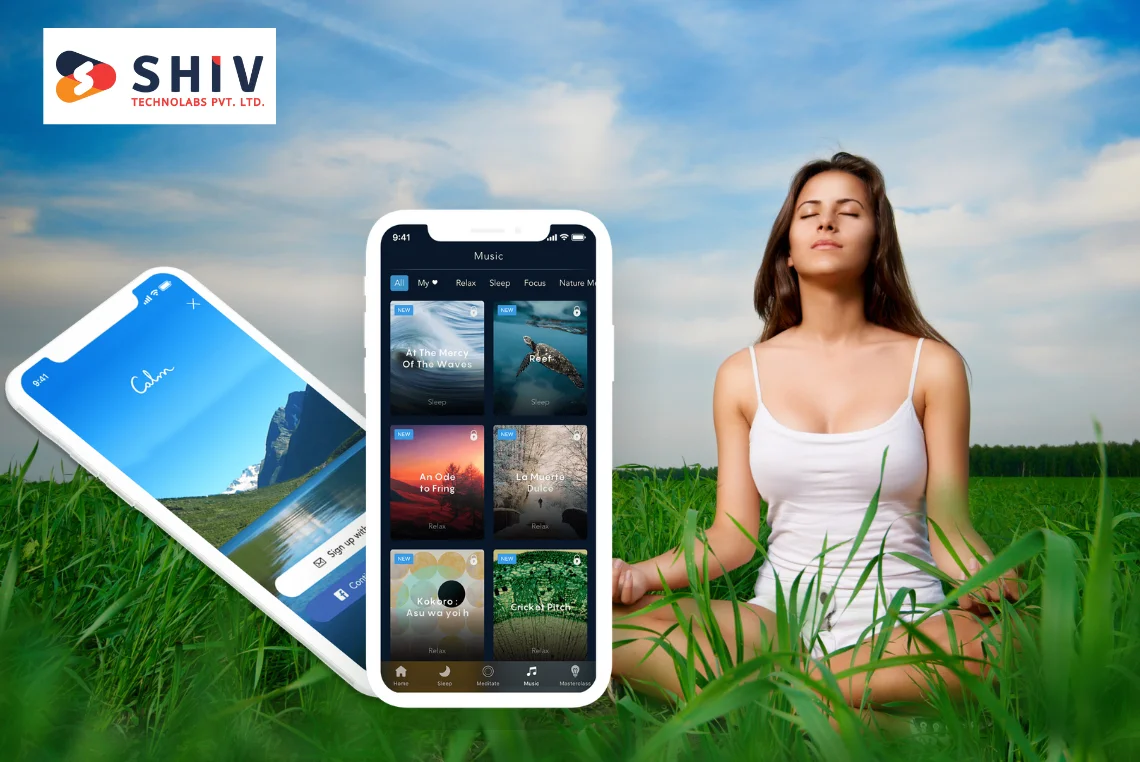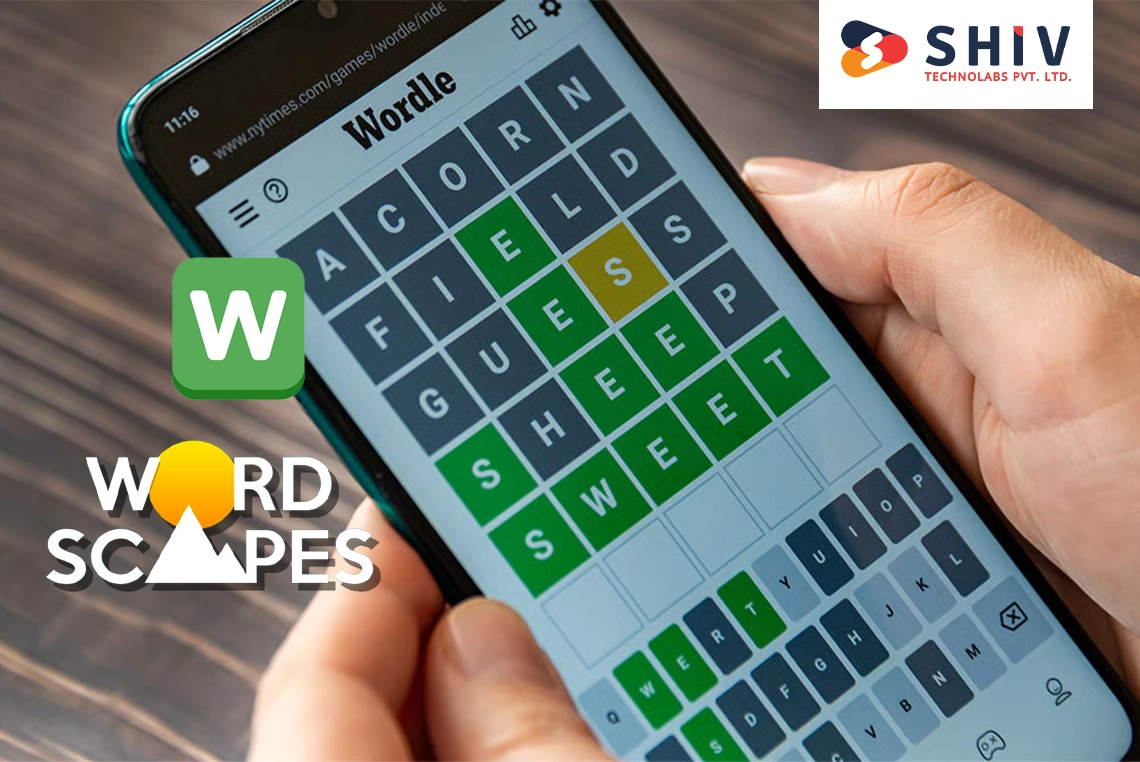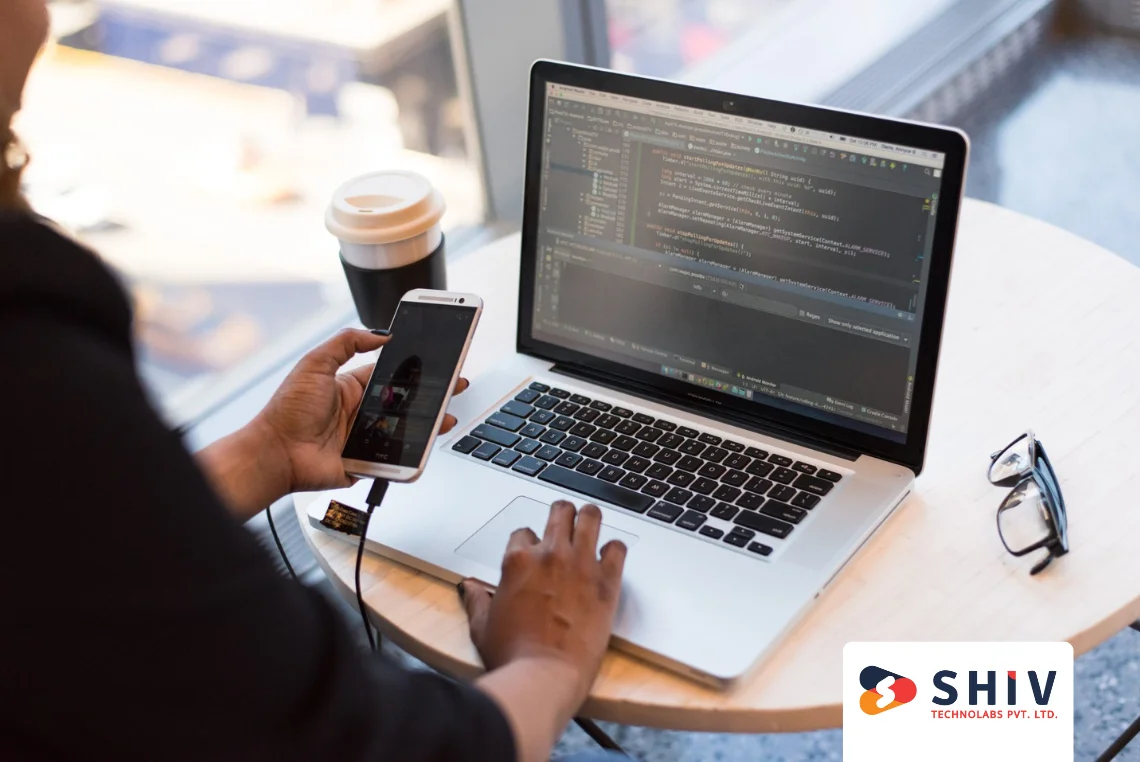Table of Contents
Mental wellness has quietly become one of the fastest-growing segments in the mobile app space.
According to Statista, the global mental wellness app market crossed $1.5 billion in 2024, with steady year-on-year growth expected.
Apps like Calm, Headspace, and Insight Timer have proven that mindfulness can be both scalable and profitable when technology meets psychology.
In a world where daily stress, burnout, and anxiety affect millions, users are turning to mobile solutions for emotional relief. A meditation app like Calm offers guided sessions, relaxing soundscapes, and self-improvement tools that fit easily into a user’s routine.
For businesses, this shift creates a strong opportunity to build apps that don’t just entertain but also improve well-being.
Developing a meditation app requires more than technical skill — it’s about crafting an experience that brings peace, focus, and habit consistency to users’ lives.
In this blog, we’ll break down the features, tech stack, cost, and process to build a Calm-like meditation app, helping startups and wellness brands create meaningful digital experiences.
What Is a Meditation App Like Calm?
A meditation app like Calm is a digital platform that helps users reduce stress, improve sleep, and build mindfulness habits through guided sessions. It blends sound therapy, psychology, and technology to create a peaceful user experience accessible to all age groups.
These apps are popular because they make wellness simple and available anytime, anywhere. Whether someone wants to calm their mind before bed or reset during a stressful workday, apps like Calm offer immediate access to tools that promote focus and relaxation.
Here’s what defines a Calm-like meditation app:
- Guided Meditations – Voice-led sessions for mindfulness, focus, and relaxation.
- Sleep Stories – Narrated bedtime stories or calming sounds to improve sleep quality.
- Mood-Based Content – AI-driven recommendations that adapt to a user’s emotional state.
- Soothing Sound Library – Natural soundscapes, ambient music, and breathing tracks.
- Daily Reminders – Gentle notifications that encourage consistency and habit-building.
- Community Features – Access to expert talks, group meditations, and shared experiences.
In simple terms, a meditation app like Calm acts as a personal wellness coach, guiding users through stress relief, sleep improvement, and emotional balance.
For startups, this concept offers a strong foundation to build a product that not only supports mental health but also connects deeply with users’ daily routines.
Must-Have Features of a Meditation App Like Calm
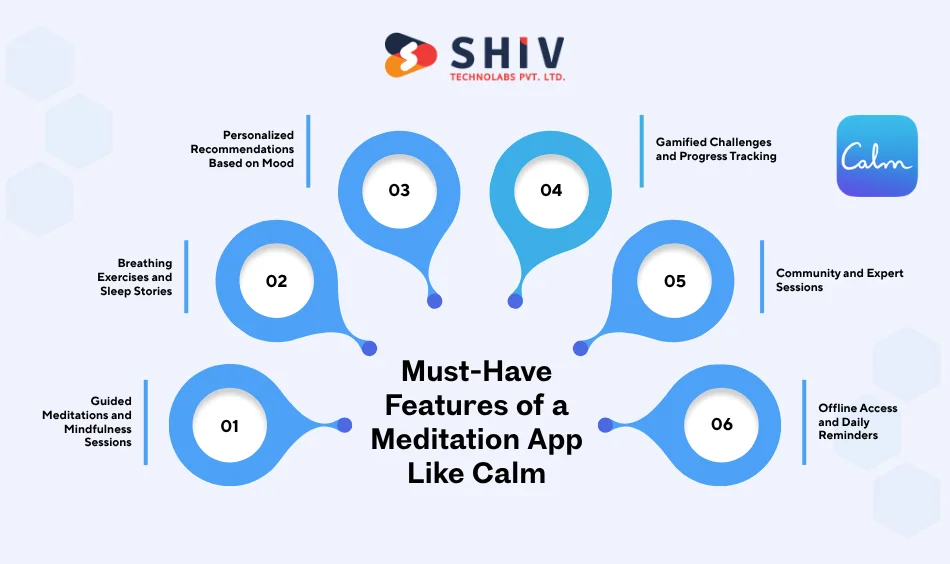
When developing a meditation app, the core focus should be on creating a calm, distraction-free experience that guides users through relaxation and self-awareness.
Successful apps like Calm and Headspace achieve this through a mix of engaging content, smart personalization, and minimalistic design. Below are the essential features your app should include.
1. Guided Meditations and Mindfulness Sessions
Guided sessions are the heart of any meditation app. Users can select from topics such as stress relief, focus, or sleep improvement. These sessions are usually available in various lengths to suit different schedules. Offering both beginner and advanced levels helps retain a wider audience.
2. Breathing Exercises and Sleep Stories
Breathing patterns can directly influence relaxation and stress levels. Including guided breathing exercises helps users regulate their energy and emotions. In addition, narrated sleep stories or calming background sounds assist users who struggle with insomnia or restlessness.
3. Personalized Recommendations Based on Mood
AI integration allows the app to track usage patterns and mood inputs to suggest suitable sessions. For instance, if a user reports feeling anxious, the app can recommend a short mindfulness exercise or calming playlist. This personalized approach improves engagement and builds daily habits.
4. Gamified Challenges and Progress Tracking
Adding achievement badges, streaks, and progress graphs motivates users to stay consistent. A sense of accomplishment turns meditation into a rewarding habit rather than a chore. This feature is particularly useful in maintaining long-term app retention.
5. Community and Expert Sessions
Community spaces where users can join live meditation events or interact with certified instructors create a sense of belonging. This helps people stay connected to their wellness goals while learning from experienced mentors.
6. Offline Access and Daily Reminders
Offline functionality allows users to continue their sessions without internet access — ideal for travelers or people in remote areas. Daily reminders encourage regular practice, helping users maintain consistency over time.
Feature Comparison Table: Calm vs. Headspace vs. Custom Meditation App
| Feature | Calm | Headspace | Custom App (Your Brand) |
|---|---|---|---|
| Guided Meditations | ✔️ | ✔️ | Custom categories possible |
| Sleep Stories | ✔️ | ✔️ | Can include brand-specific content |
| AI Recommendations | Limited | Moderate | Fully customizable |
| Progress Tracking | Basic | Advanced | Can include gamified options |
| Community Access | Limited | Moderate | Expandable via live sessions |
| Offline Access | ✔️ | ✔️ | Available with subscription |
A meditation app’s strength lies in how naturally it blends design, content, and psychology. Each of these features plays a vital role in encouraging mindfulness, promoting relaxation, and building user loyalty over time.
Tech Stack to Build a Meditation App
Selecting the right technology stack is crucial for building a meditation app that’s fast, secure, and capable of handling high-quality audio and video streaming. Since such apps rely heavily on smooth playback, personalization, and user analytics, the tech foundation must be both scalable and stable.
Below is a breakdown of the recommended technologies for each development layer.
1. Frontend Technologies
The frontend determines how users interact with the app — from visuals to navigation flow.
- Frameworks: React Native, Flutter (for cross-platform apps)
- Languages: Swift (iOS), Kotlin (Android)
- UI Libraries: Material Design, Tailwind CSS, or custom component libraries
- Animation Tools: Lottie for micro-interactions and motion effects
A calm and minimal frontend development, soothing color palette, and intuitive gestures can significantly influence user engagement in a meditation app.
2. Backend Technologies
The backend manages content delivery, user data, and overall performance.
- Frameworks: Node.js, Django, or Ruby on Rails
- Databases: MongoDB or PostgreSQL for storing user activity and preferences
- Cloud Services: AWS, Google Cloud, or Microsoft Azure for scalability
- Authentication: Firebase Auth or OAuth 2.0 for secure user sign-ins
The backend should also support push notifications, content scheduling, and media storage for audio or video sessions.
3. APIs and Integrations
To create a feature-rich experience, integrate APIs that support content delivery and user engagement.
- Audio/Video Streaming: Agora, Twilio, or AWS MediaConvert
- Payment Gateways: Stripe, PayPal, Razorpay (for in-app subscriptions)
- Analytics: Firebase Analytics, Mixpanel, or Amplitude
- AI & ML APIs: TensorFlow Lite, OpenAI API, or Google Cloud AI
Integrations like these help in offering AI-driven personalization, subscription management, and performance tracking — all essential for scaling the app.
4. AI and Machine Learning for Personalization
AI can elevate user experience by tailoring content to individual moods, progress, and listening habits.
- Sentiment analysis from journal entries or voice inputs
- Predictive recommendations based on session frequency
- Voice-based meditation coaches using Natural Language Processing (NLP)
By using these technologies, you can build an app that feels personal, learns over time, and delivers a better mindfulness experience with every session.
Step-by-Step Process to Develop a Meditation App Like Calm
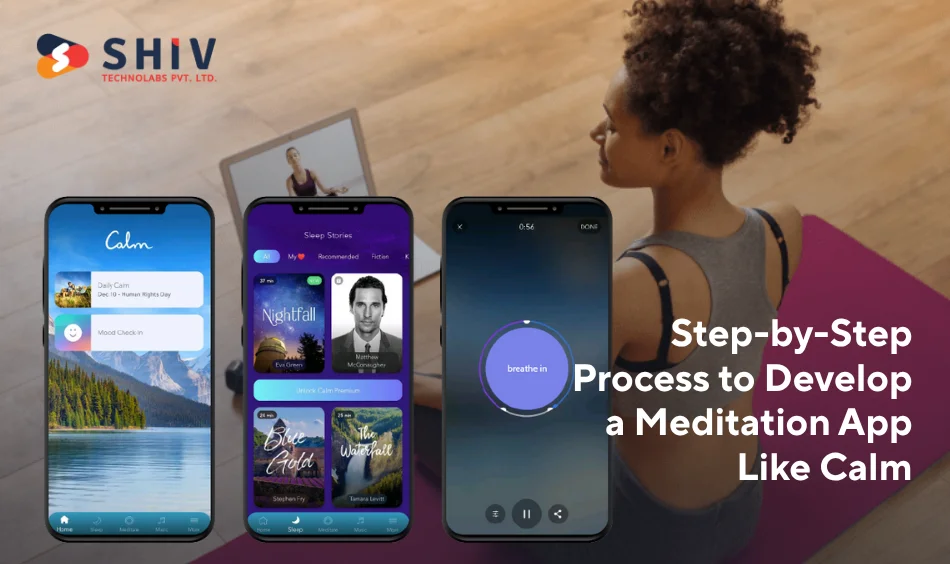
Creating a Calm-style meditation app isn’t just about coding features — it’s about translating mindfulness into a digital experience. Every step must reflect the essence of calm, clarity, and personal growth.
1. Research the Calm Framework and Identify Gaps
Start by dissecting Calm’s structure — its onboarding, navigation, tone, and user experience.
- Analyze how Calm classifies sessions (Sleep, Focus, Anxiety, Gratitude).
- Track how it uses soundscapes, stories, and celebrity voices to deepen engagement.
- Identify gaps: for example, Calm has limited regional voices or multi-language breathing guides.
This research should inform your differentiation — whether you focus on cultural meditations, voice emotion tracking, or AI-based breathing assistance.
2. Curate the Right Type of Meditation Content
Content makes or breaks a mindfulness app. You’ll need to build a structured content hierarchy like Calm’s:
| Category | Description | Example |
|---|---|---|
| Mindfulness | Daily guided sessions | 10-minute morning meditations |
| Sleep | Bedtime stories, soft music | “Drifting Clouds” sleep track |
| Focus | Productivity soundscapes | Lo-fi concentration loops |
| Emotion | Stress and gratitude meditations | 5-minute breathing resets |
Work with certified meditation coaches, psychologists, or wellness experts to script and record sessions. For credibility, Calm uses known voices like Matthew McConaughey — you could onboard regional wellness experts for authenticity.
3. Design an Emotionally Neutral Interface
Users open a meditation app to escape noise, not encounter more of it.
Focus on:
- Muted tones (pastel gradients, deep blues, or forest greens).
- Slow transitions and no sharp animations.
- A single-action layout: one tap to begin a session, no clutter.
Calm’s home screen instantly plays a background sound. Implement a similar feature with dynamic soundscapes that adjust to user preferences — rain, waves, forest, or silence.
4. Build Core Modules with Audio Precision
Meditation apps rely on audio fidelity and smooth playback. Your backend should handle:
- Adaptive audio compression to avoid buffering.
- Downloadable sessions for offline listening.
- Custom playback engine that remembers the last session time or progress.
Calm’s backend is heavily optimized for continuous playback — ensure your system does not restart tracks when users switch apps or lock their phones.
5. Integrate AI for Personalization and Emotional Context
AI isn’t just a buzzword here — it’s what makes your app feel like a living guide.
Implement:
- Mood-driven suggestions: Detect emotional patterns from daily reflections.
- AI voice matching: Adjust background tone and pitch based on user behavior.
- Smart streak reminders: Send gentle notifications when users break routine (“It’s been 2 days since your last pause”).
Unlike Calm, which uses simple history-based suggestions, an AI-powered model can identify why a user dropped off — not just when.
6. Build Community Through Live and Shared Experiences
Calm users often miss a real-time connection. Your app can fill this gap through:
- Live group meditations hosted by experts.
- Progress leaderboards for team wellness programs.
- Audio journaling, where users record reflections that remain private or shareable.
These features bring human connection into what’s often a solitary digital space.
7. Test for Emotional Flow, Not Just Functionality
Traditional QA isn’t enough. Meditation apps must be tested for emotional continuity.
- Observe how users feel after 5 minutes — relaxed or distracted?
- Check sound transition timing between tracks.
- Test color and brightness under low-light mode to avoid visual strain.
Beta testing with mindfulness practitioners or yoga instructors helps refine tone and pacing.
8. Launch Softly with Seasonal Campaigns
Calm often aligns releases with emotional seasons — “Sleep Week,” “Stress Awareness Month,” or “Mindful January.”
You can replicate that by launching your MVP around relevant events:
- Offer a free 7-day Calm Challenge to gather data.
- Partner with wellness influencers or therapists.
- Use app store visuals with calm typography and sound-based previews.
This approach builds trust before pushing premium features.
A successful meditation app isn’t defined by how advanced its tech is — it’s defined by how quietly powerful its experience feels. Every decision, from color to voice pitch, should help users pause, breathe, and reset.
Monetization Models for Meditation Apps
While mindfulness is about calmness and simplicity, a successful meditation app must also be financially sustainable.
Calm’s growth proves that users are willing to pay for premium wellness experiences — as long as the content feels personal and valuable.
Here’s how you can structure monetization for a Calm-like meditation app without compromising its purpose.
1. Freemium Access with Tiered Subscriptions
This is Calm’s primary model — users get limited access for free and unlock premium features with a paid plan.
- Free version: 10–15 short meditations, a few sleep tracks, and breathing timers.
- Premium version: Complete content library, expert-led programs, and exclusive sleep series.
- Pricing idea: $9.99/month or $59.99/year (similar to Calm’s subscription tier).
You can also offer lifetime access for a one-time payment, targeting users who prefer single purchases over subscriptions.
2. Corporate Wellness Partnerships
Calm’s corporate product, Calm for Business, is one of its biggest revenue streams. It offers employee subscriptions to companies focusing on mental health and productivity.
You can:
- Create bulk pricing models for corporate clients.
- Offer branded meditation programs for stress management or focus.
- Provide analytics dashboards showing team participation rates (while keeping data anonymous).
This B2B model helps stabilize long-term income while promoting wellness at scale.
3. In-App Purchases for Exclusive Content
Offer downloadable meditation packs, such as:
- “Sleep in 5 Days” program
- “Anxiety Reset” guided course
- “Mindful Mornings” background tracks
Each pack can feature curated voice artists or themed music, similar to Calm’s “Masterclass” section. You can also include limited-edition collaborations with mental health experts or celebrities for higher engagement.
4. Seasonal and Event-Based Subscriptions
Users are more likely to invest in wellness during certain times of the year — new year resolutions, exam seasons, or corporate burnout phases.
Offer time-bound packages such as:
- Spring Reset Challenge (30-day mindfulness pack)
- Sleep Week bundle for improving rest patterns
- Corporate Calm Month discounts for HR teams
These short-term campaigns drive both engagement and recurring revenue.
5. Affiliate Partnerships and Wellness Ecosystem Integration
Calm integrates with fitness trackers, smart speakers, and sleep devices. You can partner with:
- Wearable brands (e.g., Fitbit, Oura)
- Wellness influencers for co-created courses
- Health platforms offering combined yoga + meditation subscriptions
Cross-platform integration increases app visibility and creates consistent monetization beyond in-app purchases.
A meditation app’s monetization strategy should never feel transactional. Users must feel like they’re paying for peace of mind, not just access to content. The goal is to maintain a fair balance between free accessibility and premium experiences that genuinely improve well-being.
Cost to Develop a Meditation App Like Calm
The total cost of developing a meditation app like Calm depends on multiple factors — including app complexity, design quality, AI integration, and content production.
Unlike standard utility apps, meditation platforms require high-quality audio, adaptive soundscapes, and psychological UX design — all of which influence pricing.
Here’s a detailed breakdown of development costs based on real-world app structures similar to Calm:
| Development Stage | Description | Estimated Cost (USD) |
|---|---|---|
| UI/UX Design | Designing soothing visuals, intuitive navigation, and sound-based transitions | $4,000 – $7,000 |
| Frontend & Backend Development | Building core app modules, playback systems, and data architecture | $9,000 – $16,000 |
| Audio/Video Integration | Implementing streaming, download options, and adaptive compression | $2,500 – $5,500 |
| AI/ML Personalization | AI-based recommendations, emotion tracking, and progress prediction | $3,500 – $8,000 |
| Content Management System (CMS) | Dashboard for uploading and managing guided meditations | $2,000 – $4,000 |
| Testing & QA | Device testing for playback quality, latency, and usability | $2,000 – $3,500 |
| Post-Launch Maintenance (Annual) | Bug fixes, new content uploads, and system upgrades | $1,500 – $3,000 |
| Total (Approx.) | – | $24,000 – $47,000 |
Key Factors Affecting the Cost
- Audio Production Quality: Calm invests heavily in high-definition soundscapes and professional narrations. If you plan to record original sessions, consider studio and licensing costs.
- AI-Based Features: Sentiment analysis, adaptive recommendations, and voice-interaction models can add 25–30% to total development cost.
- Cross-Platform Support: Building for both Android and iOS simultaneously (via Flutter or React Native) is more cost-effective than developing native apps separately.
- Server and Cloud Infrastructure: Meditation apps require strong backend servers for audio streaming and user data storage. AWS or Google Cloud services add ongoing monthly costs based on user volume.
- Maintenance and Content Uploads: Regularly adding new meditations, soundscapes, and masterclasses keeps retention high. Content expansion is an ongoing cost but directly drives subscription renewals.
Developing a Calm-like meditation app is not just about upfront investment — it’s about building a long-term wellness platform. With the right balance of technology and mindful design, even a smaller budget can deliver an experience that feels as polished and purposeful as Calm.
How AI Is Transforming Meditation Apps?
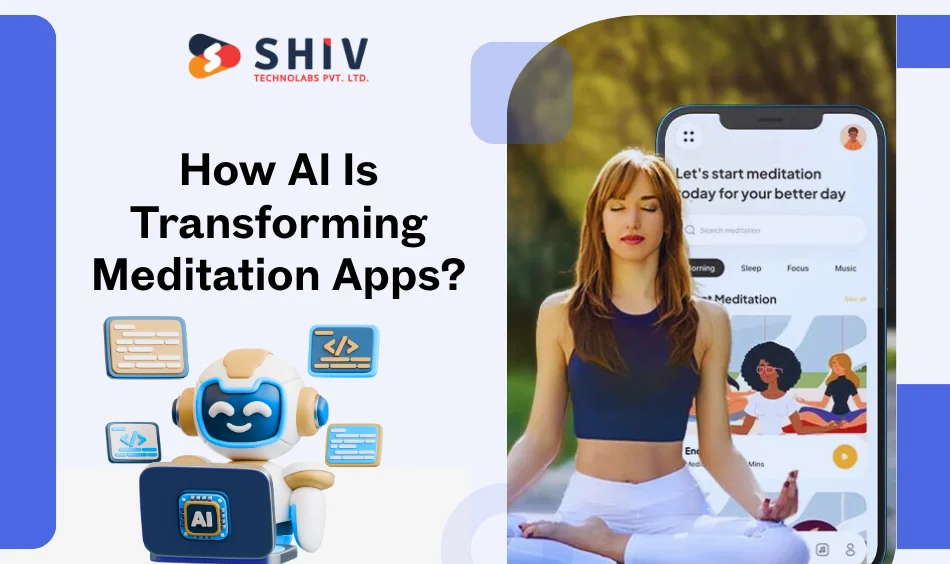
Artificial intelligence is redefining how users experience mindfulness. While Calm and Headspace have begun integrating light personalization, newer meditation apps are using AI to create adaptive, emotion-aware experiences that feel almost human.
These innovations go far beyond static playlists — they learn from user behavior, emotional cues, and listening patterns to provide deeply personalized wellness journeys.
1. Mood Detection and Emotional Tracking
AI models can analyze user inputs — such as journal entries, voice tone, or app interactions — to recognize emotional states like stress, anxiety, or restlessness.
- Example: If the system detects low mood patterns, it can suggest calming sessions or gentle affirmations.
- Integration idea: Pair mood tracking with daily reflection prompts to improve personalization accuracy over time.
This helps users feel understood rather than simply “served” generic content.
2. AI-Driven Content Recommendation
Traditional meditation apps offer fixed playlists, but AI can dynamically curate content that evolves with the user.
- Suggests meditations based on session completion, skipped tracks, or time of day.
- Uses reinforcement learning to understand what type of guidance works best — short breathing sessions, deep sleep music, or gratitude reflections.
- Enables “adaptive playlists” that shift with the user’s progress.
Such personalization increases daily engagement and helps users stick with their meditation goals longer.
3. Voice-Guided Meditation Assistants
Using Natural Language Processing (NLP), AI can create interactive voice-based experiences.
- Users can say: “I’m feeling anxious,” and the app responds with a tailored session or breathing exercise.
- Integration with virtual assistants like Alexa or Google Assistant extends accessibility to smart speakers.
- Custom voice tone adjustments maintain emotional consistency throughout sessions.
This approach transforms a static app into a conversational mindfulness coach.
4. Predictive Notifications and Retention Triggers
AI helps prevent drop-offs by predicting when users might skip their sessions.
- It detects inactivity or inconsistent behavior patterns.
- Sends gentle, personalized reminders — not spammy push alerts — such as “Would you like to continue where you left off yesterday?”
- Adapts reminder frequency based on user engagement trends.
This reduces churn while keeping the communication tone aligned with mindfulness principles.
5. Adaptive Breathing and Biofeedback Integration
When paired with wearables or sensors, AI can adjust breathing exercises in real-time.
- Integrates heart rate or stress level data.
- Adjusts pacing, background tone, or session length automatically.
- Offers data-backed insights on emotional improvement over time.
This feature bridges the gap between digital calmness and physical well-being, giving users measurable progress instead of abstract affirmations.
AI doesn’t just make meditation smarter — it makes it more personal, empathetic, and habit-forming.
For startups, implementing AI capability into the meditation app can turn into a wellness companion that grows with every user interaction.
Challenges in Meditation App Development
Building a Calm-like meditation app comes with unique creative and technical challenges.
- Authentic Content: Users trust genuine voices and calming tones. Partner with certified meditation experts to maintain credibility.
- Data Privacy: Emotional data, journal entries, and sleep logs must be encrypted and stored securely.
- Monetization Balance: Keep free tools accessible while reserving advanced programs for paid users.
- User Retention: Regular content updates and gentle reminders are key to long-term engagement.
- Performance Consistency: Audio streaming must stay smooth even on weak networks to maintain focus.
Each of these factors directly affects user trust — a crucial element for any mindfulness app.
Build a Calm-Like Meditation App with Shiv Technolabs
At Shiv Technolabs, we design and develop wellness apps that blend thoughtful design with reliable technology. Our team has experience creating AI-powered meditation platforms, sound-driven interfaces, and habit-forming mobile experiences that reflect mindfulness in every detail.
Whether you’re building a Calm-inspired MVP or scaling an existing app, we can help you plan, design, and launch a platform that feels balanced, secure, and built to grow.
👉 Let’s create your next digital wellness experience — together.
Conclusion
The success of Calm shows how technology can support mindfulness when built with empathy and precision. A well-crafted meditation app can guide users toward better sleep, reduced stress, and emotional balance — all through sound, visuals, and routine.
From intuitive design and AI-powered personalization to authentic audio content, every detail contributes to how users experience calmness through their screens. For startups, this space offers both social impact and strong business potential — provided the app stays genuine to its purpose.
If you’re ready to design a meditation platform that inspires focus and peace, the journey starts with the right team. With Shiv Technolabs, you’ll have experts who understand how to turn mindfulness into meaningful digital experiences.
FAQs
1. How long does it take to develop a meditation app like Calm?
Building a fully functional meditation app takes around 4 to 6 months, depending on complexity, content volume, and AI integration. An MVP version with core meditation and sleep features can be ready in 10–12 weeks.
2. What technologies are used to build meditation apps?
Most Calm-like apps are built using Flutter or React Native for cross-platform compatibility, with Node.js or Django as the backend. For streaming, AWS MediaConvert and Firebase are commonly used.
3. How can AI improve a meditation app?
AI enables mood tracking, personalized recommendations, and smart notifications that adapt to user behavior. It helps the app evolve with each session, creating more meaningful engagement and higher retention.
4. What features are essential in a Calm-like app?
Key features include guided meditations, sleep stories, sound libraries, progress tracking, AI-driven personalization, and offline access. These elements make the app intuitive and habit-forming.
5. How much does it cost to build a Calm-like app?
The average development cost ranges between $25,000 and $45,000, depending on design quality, AI usage, and platform support. Adding features like real-time mood tracking or voice assistants may increase this range.
6. Can I include my own meditation or music content?
Yes, you can record or license your own audio sessions and music. Partnering with meditation coaches or sound engineers helps maintain professional sound quality and authenticity.
7. How can a meditation app generate revenue?
You can monetize through subscription plans, corporate wellness programs, in-app purchases, and seasonal challenges. Calm uses a freemium model that balances free access with premium experiences.
8. What makes design important in a meditation app?
A meditation app’s design directly affects how calm users feel. Soft color gradients, minimal animations, and intuitive navigation help users relax and stay focused during each session.
9. Do I need special licenses for meditation content?
If you’re using original audio or recorded voice-overs, you should obtain proper content rights or voice talent agreements. Using royalty-free or AI-generated voices without consent can cause copyright issues.
10. Why choose Shiv Technolabs for meditation app development?
Shiv Technolabs combines technical expertise with a strong understanding of wellness app psychology. Our team builds AI-powered meditation and mindfulness platforms with features that reflect peace, balance, and usability — just like Calm.

